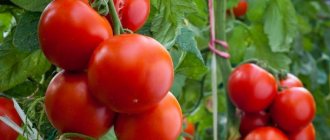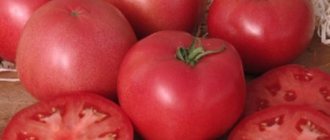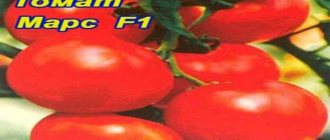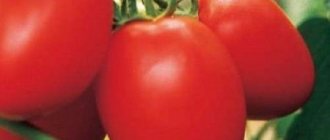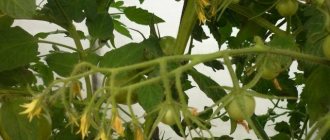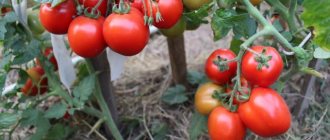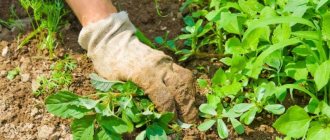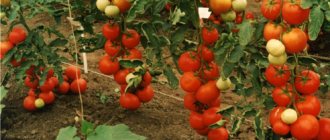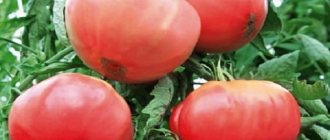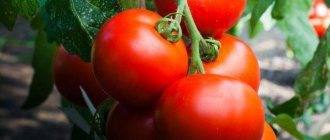Gardeners from the southern regions of Russia are lucky: they can cultivate almost all varieties of tomatoes on their plots. But for cool climates, finding hybrids and varieties of nightshade crops is not so easy. Experienced vegetable growers say: one of the best varieties is the Marfa tomato. Even under the most unfavorable climatic conditions, bushes of this variety produce a rich harvest. True, for this it is necessary to follow all the care requirements and grow the tomato in a greenhouse or in a shelter. Today we propose to talk about how to grow a Marfa tomato on your plot. Photos, reviews, advantages and disadvantages await you below!
Hybrid characteristics
Marfa belongs to the first generation hybrids. It was bred thanks to the efforts of breeders from Holland. The variety was included in the State Register of our country as intended for cultivation in open ground in the southern and central regions, and in closed ground in the northern regions of the country.
The Marfa tomato is tall, indeterminate. The height of one bush can reach about 170 centimeters. The plants are medium leafy, the bushes are not spreading. Tomato leaves are small and have a rich light green color. The bushes have a powerful root system and simple inflorescences. The very first one is formed after the 7th leaf, the subsequent ones - every next three. Speaking about the characteristics of the Marfa tomato, it should be noted that this hybrid belongs to late varieties: you will be able to enjoy ripe fruits no earlier than 135 days after the appearance of the first shoots.
The main feature of the tomato is its immunity to the most common diseases that often affect members of the nightshade family. Marfa is not afraid of fusarium, cladosporiosis, and tobacco mosaic virus. Tomatoes of this variety can be grown both in greenhouses and greenhouse shelters, and in open beds. The bushes tolerate unfavorable weather and cold snaps well.
Diseases and pests
Thanks to its excellent immunity, the Marfa F1 tomato is not afraid of verticillium, fusarium, cladosporiosis, tobacco mosaic, and root-knot nematode. Necessary preventive measures:
- By calcining or pouring a hot manganese solution, the soil is disinfected;
- After planting, tomato seedlings are sprayed with “Fitosporin” or another drug that has an antifungal and antiviral effect;
- Young tomatoes often suffer from aphids, whiteflies, and thrips. To combat flying insects, spraying is carried out using industrial insecticides or celandine decoction. Naked slugs can be effectively combated using an aqueous solution of ammonia.
Frequently washing plants with a warm soapy solution is used against aphids.
Tomato Marfa: description of fruits
Typically, fruiting begins in the second half of July and ends with the arrival of the first frost. The weight of one ripe tomato of this variety can reach 150 grams. Gardeners note high yields throughout the entire fruiting period. About 8 fruits are formed on one cluster; the yield of the Marfa variety is high - from one bush you can harvest seven kilograms of neatly rounded vegetables.
The tomato pulp is quite juicy, not watery. The taste is sweet, there is a slight sourness. At technical maturity, Marfa tomatoes acquire a rich red color. Inside, tomatoes do not have too many seeds, the skin is smooth, dense, and a small depression and a yellow-red speck usually form at the stalk. Tomatoes of this variety are distinguished by excellent presentation; they can be stored for a long time after harvest. Speaking about application, gardeners note: the variety is suitable for fresh consumption, for making sauces, ketchup, juices and soups. Tomatoes are small, so they are perfect for canning as a whole. It is important to note that during pickling, Marfa tomatoes (in the photo you can see the vegetables in cross-section) do not crack and retain their shape.
Pros and cons of the variety
Tomatoes of this variety can be grown both on an industrial scale and in small farms due to the large number of positive qualities.
- The advantages of the Marfa F1 variety include:
- high productivity;
- ease of care;
- excellent tomato taste;
- beautiful presentation;
- resistance to adverse climatic conditions;
- high transportability of tomatoes;
- good keeping quality of fresh fruits;
- immunity to diseases;
- versatility of using tomatoes.
- The disadvantages of the Marfa F1 variety include:
- mandatory formation of tall and fluffy tomato bushes;
- the need to tie up plants.
Sowing seeds and caring for seedlings
In order to ensure the maximum percentage of germination, Marfa tomato seeds must be placed in a small fabric bag before sowing and then placed on a radiator for several days. After this, it is recommended to soak them in any growth stimulator. The best options are Epin, a solution of potassium humate.
Experienced gardeners recommend that planting material be disinfected: to do this, you need to place it in a solution of potassium permanganate or hydrogen peroxide for a day. The soil for seedlings also requires special attention. The soil must be heated in the oven at a temperature not exceeding 100 degrees, or spilled with a slightly pink solution of potassium permanganate. This will destroy any viral and fungal diseases and neutralize pest larvae.
Immediately after this, you can begin to evict the seeds - pour fertile soil into the container, make grooves no more than a centimeter deep, place Marfa tomato seeds in them, sprinkle soil on top and moisten with a spray bottle. After this, it is recommended to cover the containers with glass or film and place them in a warm place. As soon as the first shoots appear, the shelter must be removed.
Rules for harvesting and storing crops
The harvest of ripe tomatoes can be harvested from mid-July until the first autumn frosts. The fruits are resistant to mechanical damage, but during harvesting they should not be subjected to shock or deformation.
For storage, select only ripe and dense fruits that do not have damage or dents on the peel. Marfa F1 tomatoes have good shelf life and can be stored for up to 35 days in a cool and dark place.
Preparing the seat
To grow tomatoes, experienced gardeners recommend choosing southwestern, southeastern or southern areas. A good harvest will be produced by those tomatoes that were planted near the southern wall of buildings or a fence. Please note: tomatoes can be successfully grown in the same place for two to three years, although organic fertilizers should be applied before planting.
The best predecessors for nightshades are cucumbers, zucchini, onions and cabbage. But you shouldn’t grow tomatoes after peppers, potatoes, and eggplants: the yield will be low and the risk of diseases will increase.
Gardeners say: it is necessary to prepare the soil for planting tomatoes in the fall, after the entire crop has been harvested from the plot. The earth should be dug up and thoroughly spilled with a solution of copper sulfate. For 10 liters of warm water you will need only one tablespoon of the product.
In the spring, you need to do another fertilizing: mix peat, humus, and add sawdust. Organic fertilizers should be added to this mixture: superphosphate (three tablespoons) and wood ash (about 500 grams). After this, the soil needs to be dug up again and thoroughly sprinkled with lime solution. All these procedures, gardeners say, are recommended to be carried out 10-12 days before you plant the seedlings in a permanent place. You can also add organic fertilizers containing nitrogen to the soil.
Description of the variety
Fruit:
- Flat-rounded, slightly ribbed, even, neat;
- With glossy thin skin;
- Having reached varietal maturity, deep red color. Near the stalk there may be depressions and yellow-red spots;
- With juicy, moderately dense, sweetish, not watery pulp, with few seeds;
- Medium size.
Bushes:
- Indeterminate, moderately spreading plant with average formation of green mass;
- Tall, reaches a height of up to 1.7 meters;
- With a powerful, well-developed root system;
- The leaves are medium in size, simple in type, dark green in color;
- The inflorescence is simple. The formation of the first inflorescence occurs above the 7-8th leaf, further ones at intervals of three leaves.
Tomato varieties for open ground:
Transplanting seedlings into the ground
Gardeners recommend planting the Marfa tomato in a permanent place at the end of May - the first ten days of June, after the danger of frost has passed and stable warm weather has established. Plants must be placed in rows; the distance between bushes is best kept at least 30-40 cm. There must be at least 50 centimeters between rows. Before planting, you need to prepare the holes, water each of them and add a small amount of fertilizer. By the way, wilted seedlings take root much worse, begin to hurt and are severely behind in development. So it’s best to plant Marfa tomatoes in a garden bed or greenhouse immediately after you take it out of the cup.
If the seedlings are very elongated, they can be planted in a lying position. By deepening the stem, additional roots are formed, thanks to which the bushes will grow faster and stronger.
Tomato care
The main task of a gardener when caring for tomatoes is timely hilling of the soil, loosening, fertilizing, watering, bush formation and timely preventive measures aimed at combating pests and diseases. Every 10-12 days, experienced vegetable growers recommend loosening the soil.
The first time this procedure must be carried out 10 days after planting the plants in a permanent place. Right before loosening, it is necessary to water the plants: hilling with damp soil will help accelerate the formation of new roots on the stem. After 20 days, a second hilling will be required. The best time for this process is the second half of the day, cloudy weather.
Throughout the summer, it is recommended to feed tomatoes with organic and mineral fertilizers. The first feeding should be done no later than 10-12 days after planting the seedlings in a permanent place. This will require 10 liters of mullein solution, 20 grams of superphosphate. One such bucket is enough for ten plants. After 2 weeks, the plants will need another feeding, preferably dry mineral fertilizers. An area of one square meter will require a mixture of 20 grams of superphosphate, 15 grams of potassium salt and 10 grams of ammonium nitrate. Another such feeding should be done after two weeks.
Due to the fact that the Marfa tomato is tall, it needs timely tying to stakes or a special rope that is stretched along the rows. It is recommended to place the stakes on the north side; the distance between the stem and the stakes should be about 10 centimeters. It is recommended to tie the plants for the first time immediately after planting the seedlings, and the second and third time as the plant grows, at the level of the second and third cluster.
Advantages and disadvantages of a hybrid
The Mars tomato has many positive qualities:
- resistant to hot southern climates;
- cold-resistant, tolerates spring temperature changes well;
- bears fruit abundantly;
- gives away the harvest together;
- does not require care;
- rarely suffers from infectious diseases;
- not picky about the composition of the soil.
Caring for crops and mature bushes comes down to loosening, timely watering and weed removal. Fertilizing is applied according to the standard scheme.
The disadvantages of hybrids include:
- the inability to grow new bushes from collected seeds with qualities similar to those of the mother plant;
- tendency to rot with excessive watering.
Among the advantages, some users highlight the size of tomatoes. Housewives like miniature vegetables. It is convenient to place small tomatoes in jars for preservation.
